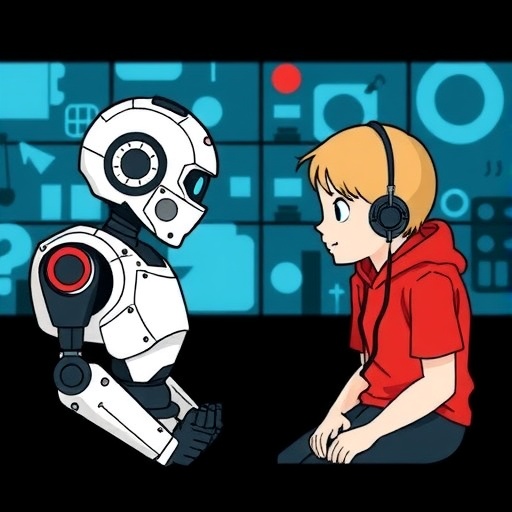In a groundbreaking study poised to make waves in the field of developmental psychology and robotics, researchers are delving into the effectiveness of varying interventions in fostering empathetic behaviors among children with autism. The research, spearheaded by a team comprised of experts Li, Lui, Song, and others, embarks on a critical comparison between traditional human-driven approaches and innovative robot-based methods. The implications of their findings could reshape therapeutic interventions for children on the autism spectrum, a demographic often challenged by social interactions and emotional understanding.
Children diagnosed with autism spectrum disorder (ASD) frequently encounter significant hurdles when it comes to developing empathy and reading social cues. In recent years, various interventions have emerged, emphasizing the role of interaction in nurturing emotional skills. This study is notable not just for its focus on empathy—a fundamental social skill—but also for its unique approach in juxtaposing human and artificial interventions, raising pertinent questions about the effectiveness of technology-assisted learning.
The researchers set out to design and implement a structured program where autistic children would engage with both human mentors and robots designed to stimulate emotional responses. The robots, embedded with artificial intelligence capabilities, were programmed to exhibit a range of emotional expressions and respond adaptively to the children’s behaviors. This dual approach presented a unique opportunity to analyze how familiar human interactions compared to engaging with a robotic counterpart could influence the development of empathy.
Over a defined period, the children participated in sessions with both types of intervention. During these sessions, they were encouraged to engage in role-playing games and exercises designed to evoke emotional responses. The human mentors, trained in empathetic communication techniques, utilized traditional methods to foster connections, while the robots employed programmed responses to mimic a degree of emotional understanding. This setup allowed the researchers to closely observe the nuances of empathetic interactions in real time.
Initial results indicated that both approaches saw varying levels of success in achieving their primary objective: increasing empathetic reactions among the participants. Interestingly, sessions involving the robots not only held the children’s attention but also appeared to enhance emotional engagement in some instances. Preliminary feedback from caregivers and educators involved in the study suggested that children who interacted with the robots demonstrated increased willingness to express emotions and share experiences.
One salient aspect of the study is how children responded differently based on the type of intervention received. While the human mentors could offer genuine emotional warmth and adapt their responses dynamically to the children’s needs, the robots operated on a consistent and engaging format that proved effective in captivating the children’s interest. This points to an intriguing dynamic where the mere presence of predictability in robotic interactions may reduce anxiety and create a safer environment for emotional exploration.
Moreover, the research team meticulously gathered data to assess the changes in empathetic behavior pre- and post-intervention, employing standardized measurement tools aimed at gauging emotional responsiveness. These tools sought to quantify outcomes by evaluating aspects such as emotional identification, perspective-taking, and altruistic behavior. It became crucial to ascertain if the changes were a result of the interventions or temporal variability in the children’s emotional development.
As the study progresses, the researchers are keen on unpacking the sustained effects of these interventions. One engaging inquiry is whether the skills developed through robotic interactions translate into real-world situations that require empathy, such as in school settings or within familial relationships. Their hope is that by understanding and harnessing these differences in interaction styles, they can further refine therapies that could vastly improve the social lives of autistic children.
The implications of this study extend beyond immediate therapeutic benefits; they raise fundamental questions about the role of technology in education and emotional development. As artificial intelligence becomes increasingly embedded in various facets of life, understanding its utility in fostering human emotional skills is paramount. A successful integration of robotics in therapeutic contexts could signal a new era in special education, shaping not only how empathetic skills are taught but also how children perceive social relationships.
Critics of robot-based interventions often raise concerns regarding the emotional authenticity offered by machines. It remains a critical discussion point among psychologists and educators—whether robots can truly foster emotional skills or simply simulate engagement without nurturing genuine emotional connections. As such, researchers involved in this study are addressing these critiques head-on, seeking to outline the potential and limitations of robotic interaction in emotional education.
Ultimately, as this research unfolds, it aims to provide a roadmap for future investigations into human-robot interactions. With the world rapidly advancing towards increased automation and technological integration in education, replicating emotionally-rich interactions via robots may not only be feasible but also transformative. This could herald a new frontier in therapy, driven not solely by human interaction but by innovative methodologies that harness the strengths of artificial intelligence.
In conclusion, the findings from this comparative effectiveness study promise to ignite essential discussions around the intersection of emotional development and technology in educational settings. As the research team continues to analyze the data and explore the implications of their findings, the education community, therapists, and families supporting autistic children remain cautiously optimistic. The continued exploration of empathetic interventions holds the potential to revolutionize how we engage with and support one of society’s most misunderstood groups, making strides towards a more inclusive understanding of emotion and interaction.
Subject of Research: Comparative Effectiveness of Human- and Robot-Based Interventions in Increasing Empathy Among Autistic Children
Article Title: Comparative Effectiveness of Human- and Robot-Based Interventions in Increasing Empathy Among Autistic Children
Article References:
Li, XH., Lui, M., Song, XK. et al. Comparative Effectiveness of Human- and Robot-Based Interventions in Increasing Empathy Among Autistic Children.
J Autism Dev Disord (2025). https://doi.org/10.1007/s10803-025-07054-w
Image Credits: AI Generated
DOI:
Keywords: Autism, Empathy, Robots, Human interaction, Behavioral therapy, Emotional development, AI in education.
Tags: artificial intelligence in emotional educationcomparing human and robot mentorsdevelopmental psychology and roboticsemotional skills development in ASDemotional understanding in children with autismempathy-building strategies for ASDfostering empathy in children with autismhuman vs. robot interventions in autisminnovative therapeutic interventions for autismrobot-assisted therapy for autismsocial interactions and autism spectrum disordertechnology-assisted learning for autistic children





